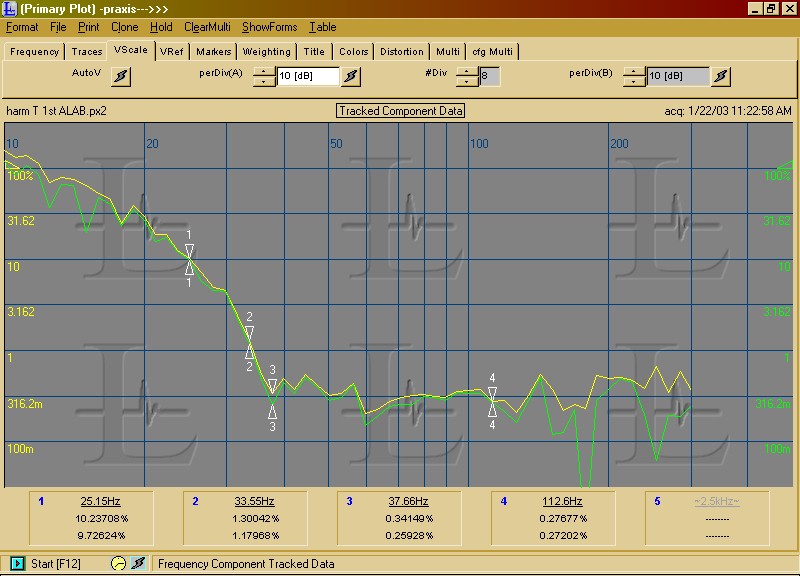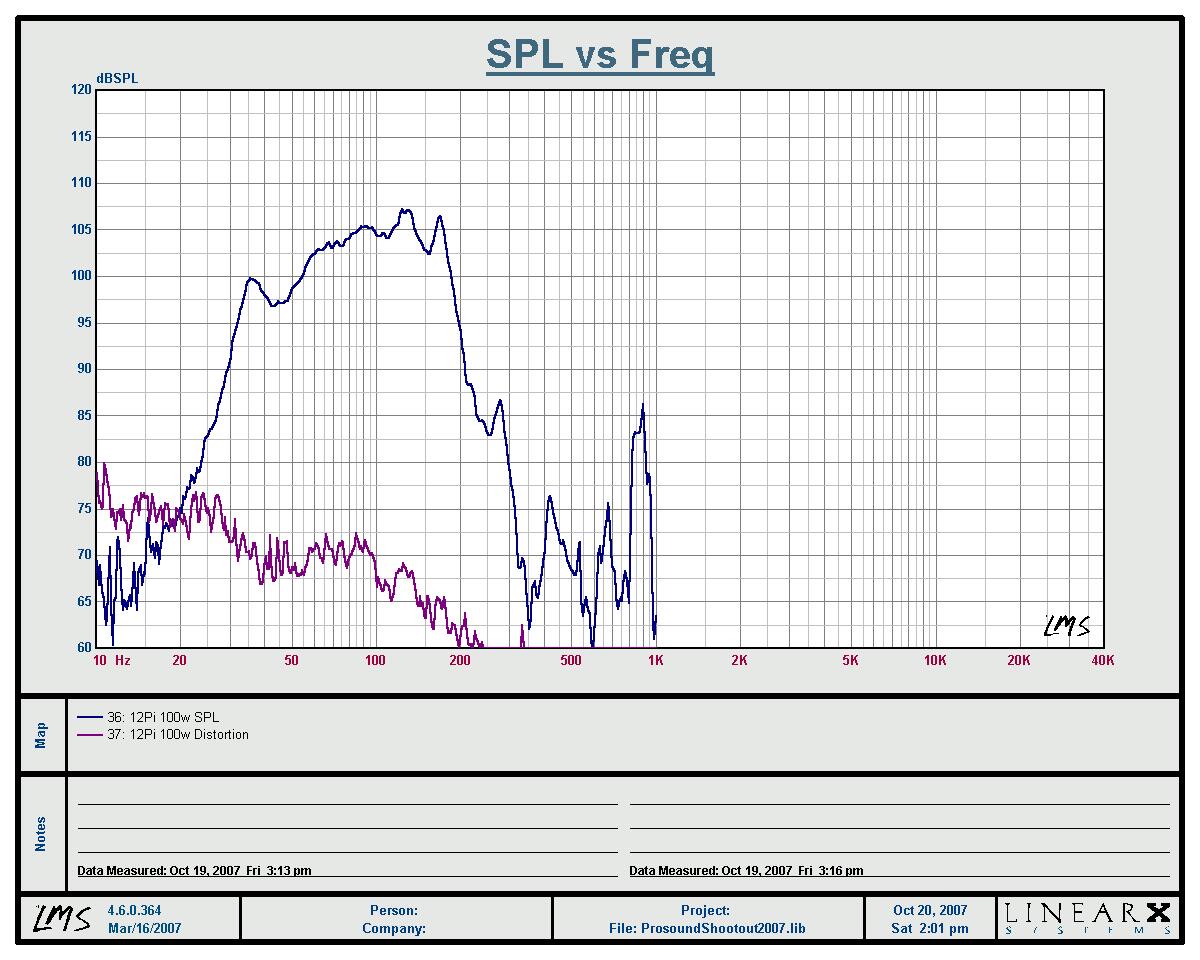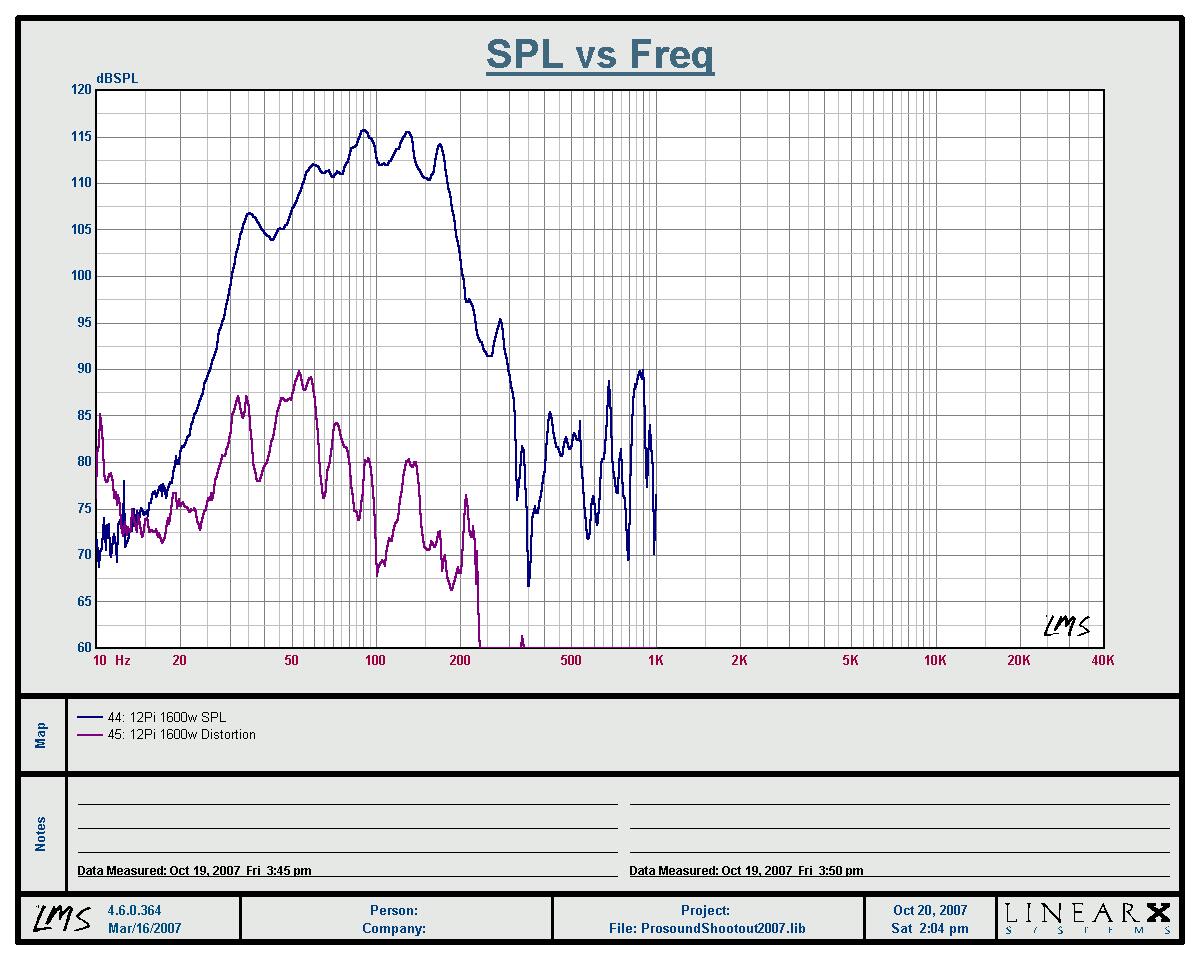

Posted by Wayne Parham [ 70.234.159.182 ] on November 16, 2007 at 16:07:28:
In Reply to: Push-pull benefits quantified posted by Wayne Parham on October 25, 2007 at 11:22:15:
I did a quick search of the internet to find the LABhorn distortion measurements from the Michigan shootout in 2003. There are some differences between the Tulsa data and the Michigan data that make this less than an "apples to apples" comparison, but I think it is still good information.
The graph below is distortion of a LABhorn measured with "9-12 volts input". I'm not sure why the voltage wasn't recorded more precisely than that, but in any case, that's less than 40 watts.
Since the LABhorn presents about 4Ω load impedance, 9 volts is 20 watts and 12 volts is 36 watts. We're only talking about 10 to 20 watts per woofer being sent for the distortion measurements. I wouldn't expect much distortion at these power levels, because they're so low.

As you can see, even at just 10v, distortion at 25Hz is already at 10%, rising rapidly at frequency falls. As one would expect from a basshorn, it is lowest in the passband, but rises rapidly at the cutoff frequency. From 35Hz down, distortion ramps up heavily, already above 3% at 30Hz even at the low drive level of 10v. By 20Hz, it is at 30% distortion, again, at only 10v input signal.
These figures aren't unexpected. If you double the drive signal, you'd see that distortion would be louder than the fundamental at 20Hz, probably also at 25Hz. At 30Hz, distortion might be about equal to the fundamental, or maybe slightly less. If you increase drive even more, nearing maximum power, distortion of the LABhorn would be even worse. This is no slam of the LABhorn, all basshorns are like this. They work best when used in their passbands, and as you get close to their lower cutoff frequency, distortion rises rapidly. That's just the way it is.
Except for the 12π with its push-pull drive. Look at the charts below. The blue line is SPL and the violet line is distortion. This is a single horn, run at 100 watts - four times as much power as was used to test the LABhorn.

Distortion is so low at this power level that we really can't see it because it's below the noise floor. The violet line shows the noise floor, so you can't really say what level the distortion is, only that it is below 1% across the entire chart.
The distortion curve is shown in decibels, and to convert these values to percentages use the chart at the link below. The noise floor was about 70dB, so anything below that is indeterminate.
One thing that is clearly evident is the absense of distortion at very low frequencies. Distortion from most subwoofers rises rapidly below a certain point where cone motion becomes uncontrolled. Notice that distortion from the 12π hornsub doesn't rise at low frequencies like it does on other basshorns without push-pull drive. This makes a cleaner, tighter sounding bass. Everyone notices the difference in sound right away.
Now for the real nut cutter. How does the performs at high power levels. To illustrate, let's take the measurements on the other end of the scale, where distortion is at its worst. You really have to hit the 12π's with several hundred watts before distortion starts to creep up above the noise floor. So lets look at the 12π chart taken at 1600 watts:

Now you can see some distortion rising above the noise floor. See down there at 10Hz? It has started rising there. You also see some at 30Hz and 50Hz, about 20dB below the fundamental, which is about 10%. So by 1600 watts, we're seeing 10% distortion. It stays under 10% down all the way to about 20Hz, where it finally rises. Below 20Hz, the horn is actually very quiet, there's not much output either fundamental or distortion, but as you can see from the chart, at 1600 watts, you don't want to push 10Hz through them. That's not what they're designed for anyway.
Now let's compare that to the LABhorn, shall we? We can't do the same 1600 watt sweep we did in Tulsa, because LABhorns won't survive it. Not a single sweep. If you set the amplifier voltage for 65v and run a sweep, you'll smoke the drivers before the sweep ends. Without cooling plugs, the LAB12's just won't survive it. I know, I've tested these things a lot, and the stock LAB12 just won't do it.
The measurements from the Michigan shootout show the LABhorn produces 30% distortion at 20Hz with only 25 watts input. Distortion from a 12π basshorn subwoofer doesn't rise to this level until it reaches a thundering 1600 watts. That's 64 times more power!
Even with just the 25 watt chart for the LABhorn, we can clearly see a difference in the LABhorn and the 12π basshorn subwoofer. Where the distortion rises below 35Hz in the LABhorn, it rises much more slowly in the 12π. The same distortion you're getting from LABhorns at 25 watts, you don't see in the 12π until it reaches 1600 watts.
The push-pull arrangement is most effective at very low frequencies. It is designed to be of most benefit near cutoff, where the horn is starting to lose its ability to load the cone. It does that beautifully, as the data clearly shows.
[ PiSpeakers Forum ] [ Help ]